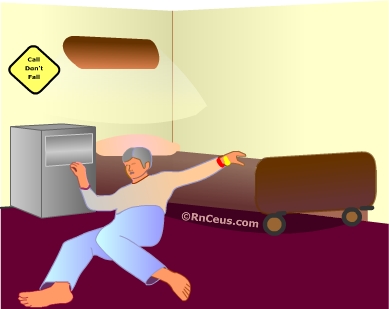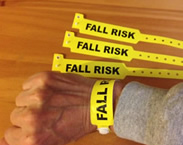Patient Falls
Definitions
• Fall
 There is no universally accepted definition of a patient fall. In fact, The Joint Commission (TJC) allows each accredited facility to determine what constitutes a patient or resident fall (TJC, 2008).
There is no universally accepted definition of a patient fall. In fact, The Joint Commission (TJC) allows each accredited facility to determine what constitutes a patient or resident fall (TJC, 2008).
Some fall definitions are succinct; an event which results in a person coming to rest inadvertently on the ground or floor or other lower level (WHO, 2012). Some are detailed; “loss of upright position that results in landing on the floor, ground or an object or furniture or a sudden, uncontrolled, unintentional, non-purposeful, downward displacement of the body to the floor/ground or hitting another object like a chair or stair” (VA National Center).
Others provide guidance; “fall” refers to unintentionally coming to rest on the ground, floor, or other lower level, but not as a result of an overwhelming external force (e.g., resident pushes another resident). An episode where a resident lost his/her balance and would have fallen, if not for staff intervention, is considered a fall. A fall without injury is still a fall. Unless there is evidence suggesting otherwise, when a resident is found on the floor, a fall is considered to have occurred (DHHS).
• Hospital Acquired Condition (HAC)
HAC is defined by the Centers for Medicare & Medicaid Services as conditions that are: (a) high cost or high volume or both, (b) result in the assignment of a case to a DRG that has a higher payment when present as a secondary diagnosis, and (c) could reasonably have been prevented through the application of evidence-based guidelines. In other words, preventable, serious injury that resulted from care provided to the inpatient.
Incidence of fall related HACs
AHRQ Partnership for Patients (PfP) Hospital Acquired Condition (HAC) Falls Data by Year |
| Year |
20101 |
20112 |
20123 |
20134 |
20145 |
| (PfP) inpatient fall HACs |
260,000 |
260,000 |
230,000 |
240,000 |
260,000 |
| Source1,5 |
Agency for Healthcare Research and Quality Publication #16-0009-EF.. Appendix: Incidence of Hospital-Acquired Conditions in the Partnership for Patients: Estimates and Projected and Measured Impact. November 2015. Exhibit A2. http://www.ahrq.gov/professionals/quality-patient-safety/pfp/index.html |
| Source2,3 |
Agency for Healthcare Research and Quality Pub. No. 14-0068-EF September 2014. Updated Information on the Annual Hospital-Acquired Condition Rate: 2011 and 2012. http://www.ahrq.gov/sites/default/files/wysiwyg/professionals/quality-patient-safety/pfp/hacrate2011-12.pdf |
| Source4 |
Agency for Healthcare Research and Quality Publication No. 16-0006 -EF October 2015. 2013 Annual Hospital-Acquired Condition Rate and Estimates of Cost Savings and Deaths Averted From 2010 to 2013. Exhibit A1. http://www.ahrq.gov/sites/default/files/publications/files/hacrate2013_0.pdf |
The reported inpatient fall rate varies widely in the literature. A recent study found patient characteristics, nursing unit, hospital culture, environment, equipment and procedures influenced the rate of patient falls. Fall rates ranged from 0.2 to 13.3 falls per 1,000 patient days in medical nursing units. They classified these units as low and high-fall units. A significant difference between the low and high-fall rate units was found to be the patient turnover rates. High-fall rate units had higher patient turnover rates. They found that more time was spent by nursing personnel on admissions and discharges and that those units with higher patient turnover rates tended to be physically larger with increased distance between nursing stations and patient rooms. Hospitals with greater than 300 beds were found to have a 6% lower fall rate than smaller hospitals. (Staggs et al., 2015)
A study of 8915 units using 2008 statistics, reported the following fall rates by unit type:
- Critical care -1.32 falls per 1000 patient days
- Step down units - 3.28 falls per 1000 patient days
- Medical units – 2.64 falls per 1000 patient days
- Surgical units – 2.89 falls per 1000 patient days
- Medical-surgical mixed units – 3.55 falls per 1000 patient days
- Rehabilitation units – 3.61 falls per 1000 patient days (He et al., 2012).
Of the patients who fall, 3% to 20% will sustain an injury, 6% to 44% of those injuries are serious, such as fractures, subdural hematomas, excessive bleeding all of which can lead to a death. Even minor injuries can cause delay in recovery (Oliver et al., 2010).
The Agency for Healthcare Research and Quality (AHRQ) reported in its handbook, Patient Safety and Quality: An Evidence-Based Handbook for Nurses), every year inpatient falls resulted in 90,000 serious injuries and 11,000 deaths in American hospitals (Hughes, 2008).
The Joint Commission’s (TJC) Sentinel Event database "has 465 reports of falls with injuries since 2009, with the majority of these falls occurring in hospitals. Approximately 63 percent of these falls resulted in death, while the remaining patients sustained injuries." Analysis of falls with injury in the Sentinel Event database reveals the most common contributing factors pertain to:
- Inadequate assessment
- Communication failures
- Lack of adherence to protocols and safety practices
- Inadequate staff orientation, supervision, staffing levels or skill mix
- Deficiencies in the physical environment
- Lack of leadership (TJC 2015)
Patient Fall Risk Assessment
Components of the Morse Fall Scale |
- History of falling
- Secondary
diagnosis (syncope, etc.)
- Ambulatory aids
- Physical assistance, wheelchair
- Crutches, cane, walker
- Furniture
- IV tubing or access
- Gait or transferring mobility
- Cognitive impairment
|
Patient fall risk should be a integral part of the initial nursing assessment in most acute and long-term care settings. In addition, the patient's fall risk should be reassessed whenever a health status change occurs.
The Morse Fall Scale (MFS) is a popular fall risk assessment tool. The MFS has been validated in a number of settings and has been found to be most useful when the intervention cut-off values are adjusted to reflect the fall rate in a particular care setting.
The American Geriatrics Society suggests the “Get Up and Go Test” as an assessment tool for any older person who has experienced a fall. It is a brief test used to identify "at risk" patients who need further evaluation. When you are prepared to break a potential fall, ask your patient to:
- Stand from a sitting position without the use of their arms for support
- Walk several paces, turn and return to their chair
- Sit without the use of their arms for support
Fall reduction strategies
Fall prevention demands a high level of organizational commitment. Every level of the organization has a role to play from resource allocation by administrators to continuous facility safety maintenance by ancillary staff. Nursing is critical to fall prevention success.
- Evaluate every patient for fall risk using a standardized and unit validated assessment tool on admission and whenever treatment or patient conditions changes.
 Communicate patient fall risk using:
Communicate patient fall risk using:
- Visual identifiers like yellow colored: bracelets, non-slip footware and signage
- Patient and family education
- Document fall risk in electronic health record for appropriate staff notification
- Patient centered intervention
- Universal fall prevention protocol
- Behavioral interventions
- Impaired moblity prevention
- Environmental safety measure
- Observation and Surveillence
- Intentional rounding, scheduled toileting
- Safety companions
Resources
- The United States Department of Veterans Affairs is a leader in patient safety. In 1999 the VA established a National
Center for Patient Safety. The VA generously offers its Falls Toolkit online.
- Center for Disease Control
and Prevention: Preventing
Falls among Older Adults online.
References
- The Joint Commission (TJC). Standards FAQ Details. Fall Reduction Program - NPSG - Goal 9 - 09.02.01. Updated 12/09/2008. Accessed 3/2/16 http://www.jointcommission.org/standards_information/jcfaqdetails.aspx?StandardsFaqId=729&ProgramId=47
- World Health Organization. Media centre. Fact Sheet No 344, OCT 2012. http://www.who.int/mediacentre/factsheets/fs344/en
- VA National Center for Patient Safety Falls Notebook, Falls Policy. Accessed online 1/9/16 http://www.patientsafety.va.gov/docs/fallstoolkit14/05_falls_policy_overview_v5.docx
- Department of Health & Human Services (DHHS) Centers for Medicare & Medicaid Services (CMS). CMS Manual System. Pub. 100-07 State Operations Provider Certification. Transmittal 27
http://www.sorbashock.com/documents/Medicare_Medicaid.pdf
- Centers for Medicare & Medicaid Services. Hospital-Acquired Conditions. Accessed 4/7/16 https://www.cms.gov/medicare/medicare-fee-for-service-payment/hospitalacqcond/hospital-acquired_conditions.html
- Staggs, V.S., Mion, L.C., Shorr, R.I. (2015).Consistent differences in medical unit fall rates: implications for research and practice. J Am Geriatr Soc., 63(5)983-7.
- He, J., Dunton, N., Staggs, V. (2012). Unit-level time trends in inpatient fall rates of US hospitals. Med Care., 50(9) 801-7.
- Oliver, D., Healey, F., & Haines, T.P. (2010). Preventing falls and fall-related injuries in hospitals. Clin Geriatr Med. ,26(4)645-92.
- Hughes, R. G. (2008). Patient Safety and Quality: An Evidence-Based Handbook for Nurses. Currie, L. Chapter 10 Fall and injury prevention. Rockville, MD: Agency for Healthcare Research and Quality.
- The Joint Commission Sentinel Alert Issue 55, September 28, 2015
- Appendix: Incidence of Hospital-Acquired Conditions in the Partnership for Patients: Estimates and Projected and Measured Impact. November 2015. Agency for Healthcare Research and Quality, Rockville, MD. http://www.ahrq.gov/professionals/quality-patient-safety/pfp/interimhac2014-ap1.html
©RnCeus.com
There is no universally accepted definition of a patient fall. In fact, The Joint Commission (TJC) allows each accredited facility to determine what constitutes a patient or resident fall (TJC, 2008).
 Communicate patient fall risk using:
Communicate patient fall risk using: